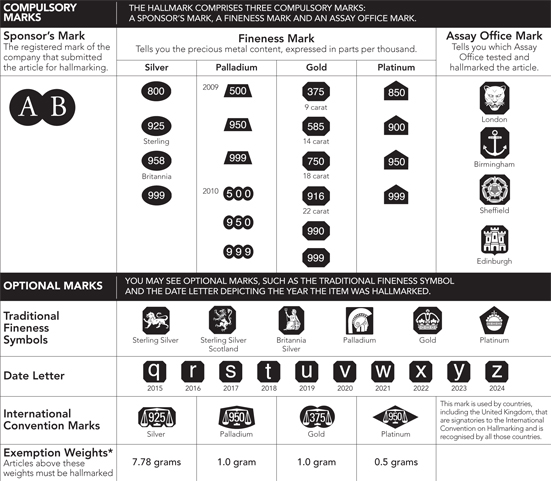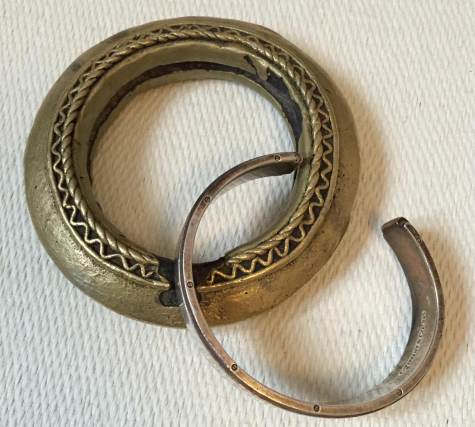Is your family heirloom worth a small fortune? How can you tell the difference between brass and Viking gold, solid silver and cheap plate? Taking your old bling and scrap metal to the ‘CASH FOR GOLD’ corner shop may seem like an obvious solution, but can you trust them to give you an honest answer and a fair price for your outmoded jewellery?
On Tuesdays this term our focus is on recycling scrap metal into new and desirable form, and it’s essential that we identify and separate precious metals before firing up the torch to recycle your unwanted jewellery. So, how can we tell what’s what?
Seven simple steps to identify precious metals…
Once you’ve handled them for a while you begin to gain an instinctive appreciation of the varying characteristics of metals. How a piece of jewellery looks, feels and smells will give us a first impression that influence our final verdict. So what are we looking for?
Is it magnetic?
Run a strong magent over your scrap. Anything that reacts to the magnet has steel in it. Throw it away now.
EXCEPTIONS: Lobster clasps, ball catches and other items that have a spring action to them may well be made from gold or silver, but are likely to contain a steel spring which your magnet may pick up on. If you intend to melt this down, do some additional testing first so you know the item is otherwise precious, then in the melting process scrape the steel element out of the pool of molten metal – steel has a high melting point so will remain obvious and solid.
What colour is the metal?
If it’s silver-coloured it could be:
Aluminium / Pewter/ Steel / Nickel / Titanium/ SILVER/ GOLD / PLATINUM / PALLADIUM
Also – Where did the jewellery come from? The design might suggest an answer here. If it’s from South America or the far east it could be any of these alloys, often having no silver content at all and certainly not pure enough for us to be able to make use of .
Alpaca / German Silver / Tibetan Silver / Thai Silver / Mexican Silver
If it’s gold-coloured it could be:
Brass / Bronze / GOLD
If its reddish-coloured it could be
Copper / Bronze / GOLD
Does the colour of the metal vary across the piece of jewellery? Look out for colour changes on the edges and on raised elements of the design that suggest the piece has been plated. Lots of high street jewellery will be silver or gold plated copper, brass or bronze, or sometimes nickel, pewter, aluminium or steel, and the plate wears readily at the edges. If you are suspicious, take a file to it in a discreet place; look out for a new colour below the immediately visible surface.
Does it smell metallic when you rub the metal?
Metals like brass, copper, aluminium and steel all have quite distinct metallic smells – or rather, the metal oxides present on these metals tend to smell. Sterling silver also has some smell, perhaps due to the copper content of this alloy. But the higher metals are not known to present any odour when rubbed, due to their resistance to oxidation or corrosion. This is an easy identifier between brass and gold.
Does it feel right?
Because every metal varies in density you can make a good guess at the likely quality of a piece of jewellery. For example, aluminium being light (as well as too light grey in colour) is unlikely to be confused with silver because it will be unexpectedly light in the hand. Platinum, by comparison, will feel extremely heavy. Here’s a useful chart that gives the specific gravity (comparative weight-to-volume) of our metals
Does it have a Hallmark?
You’d think that the most obvious proof of preciousness would be in the hallmark of a piece of jewellery, but in these times of tricksters and smoke screens ‘fake’ is all the rage, and in our business this is no exception. We have in the UK very strict regulations regarding the sale of precious metals, and there should (with a very few exceptions) be a visible hallmark that shows the piece has been assayed, which describes the quality of metal in your jewellery. But other parts of the world are less than rigourous about regulating the sale of precious metals and we need other ways to verify. Check you items for marks, but be wary of trickster numbers or a random partial word. Silver coloured objects are often marked with a stamped ‘silver’ or ‘925’ mark. This is no guarantee of metal quality. Use another method for verification.
Here’s a chart of the common control marks for the UK

Try the Acid Test
Buy a metal testing kit, if you have lots of scrap to test. The kits are not cheap, and annoyingly they will go off over time, becoming un-reactive and unreliable. Also the acids are dangerous to inhale and touch so make sure you follow strict health and safety guidelines. Wear rubber gloves, use in a well ventilated environment. Thoroughly wash all metal parts and tools and everything that came near the stuff. The kit will distinguish base metals from silver, and lower metals from higher carat golds. Buy a 3 acid or 5 acid kit depending on your particular needs.
Try the temperature test
This test assumes you are truly consigning your scrap for recycling…
All metals have differing melting points. Thus heating your object will readily discount certain possibilities. So a silver coloured object that melts with the heat of a lighter we can safely assume to be made from a high tin (or lead) content metal like pewter; if it melts between 800 and 900˚C (orange to yellow in colour) then it’s silver, but if you need to go above 1300˚C and the metal is becoming white hot then you have one of the platinum/palladium group. Remember that you must wear protective shades when heating above 1300˚C. See that handy Metal Comparisons chart again for melting temperatures.
Make sure when you are using this test that you have used a separate crucible from the ones you intend to use for gold and silver. You don’t want to contaminate other metals.
And if you are still uncertain, still baffled by the conclusions you have drawn from all these tests, then I suggest you take the risk with you local cash converters!
Good Luck.
Our Recycling Silver course on Tuesday evenings will give you the opportunity to identify and separate your scrap metal, before melting and casting it into ingots for processing into useful form – sheet or wire. Learn how to make your own alloys, and we’ll also be covering delft sand and cuttlefish casting.
Book Now
Or why not try Etching Techniques for Jewellery? Learn how to apply resists and acids to cut patterns into your copper and silver jewellery. Thursday Evenings for 10 weeks.

